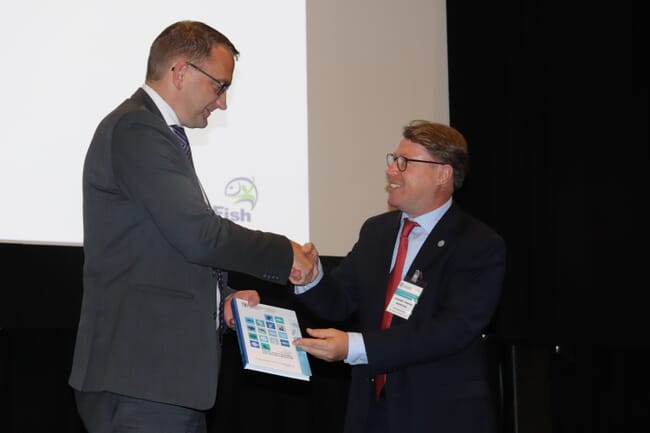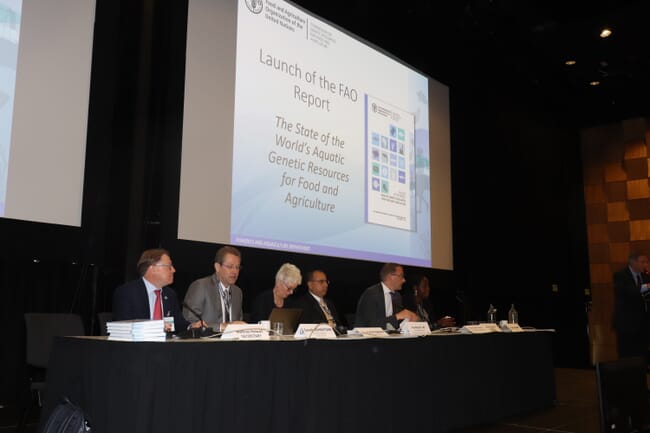This was the key message delivered by Matthias Halwart at the launch of The State of the World's Aquatic Genetic Resources for Food and Agriculture in Trondheim today (23 August).

The first-ever report of its kind, it was hailed by Halwart as “a milestone” for developing global knowledge on aquatic genetic resources both in capture fisheries and in aquaculture. Graham Mair, also from FAO’s fisheries and aquaculture department, then went on to explain how the report had been created, since the idea for it was first mooted back in 2007.
It was based, he explained, on information provided by 92 countries, together representing 96 percent of global aquaculture production and over 80 percent of capture fisheries production.
The report notes that aquaculture is lagging far behind terrestrial agriculture - both crops and livestock - in terms of the characterisation, domestication and improvement of its genetic resources for food production. The report concludes that there is a great opportunity to significantly enhance sustainable aquaculture production through the strategic management and development of some of the more than 550 species currently used in aquaculture.
According to the report, we are still largely farming wild fish, with 45 percent of cultured species being little different from their wild counterparts. The report also notes that just over half of the reporting countries consider that genetic improvement is having a significant impact on their aquaculture production, in contrast with the extensive use of improved breeds and varieties in livestock and crop production. The report stresses the potential for sustainable production gains through the genetic improvement of farmed aquatic resources.
"I strongly welcome this report which is the fruit of a multi-year, country-driven process of data collection and analysis," said FAO director-general Qu Dongyu. "It highlights the pressures that a growing demand for fish and fish products will place on farmed species, their wild relatives, and the habitats they depend on, as well as the opportunities for sustainable growth. This is why it is crucial that we safeguard, manage and further develop the planet's aquatic genetic resources, allowing organisms to grow, to adapt to natural and human-induced impacts such as climate change, to resist diseases and parasites, and to continue to evolve to help achieve the [UN’s] Sustainable Development Goals and our continued fight for a sero hunger world."

Unleashing aquaculture's potential
According to FAO, a growing human population is expected to drive an increase in fish consumption of approximately 1.2 percent per annum over the next decade. Production of fish and fish products is estimated to reach over 200 million tonnes by 2030.
Given that production from the world's capture fisheries has stabilised at about 90-95 million tonnes per annum, with nearly a third of marine fish stocks being overfished, there is little scope for additional production in the foreseeable future except through loss and waste and efficiencies management. The expected growth in demand for fish and fish products therefore needs to be largely met from aquaculture. In this context, the responsible and sustainable use of aquatic genetic resources will be essential to fulfill this role.
Numerous technologies are available to improve aquatic genetic resources with FAO recommending a focus on well-designed, long-term selective breeding programmes, which can increase productivity of aquatic species by 10 percent per generation.
Wild species under threat
The report notes that all farmed species still have wild relatives in nature but many of these wild species are under threat and are in need of targeted and prioritised conservation. The report calls on countries to develop policies and actions to address this need.
According to the report, the most depleted wild relatives of cultured species are Russian sturgeon, huchen, beluga sturgeon, Atlantic salmon and brown trout.
The report also notes the potential impacts of escapes including of non-native species, from aquaculture farms, on biodiversity and ecosystems, and calls for the responsible exchange and use of native and non-native aquatic genetic resources.
Strengthening policies and cross-sectoral approach
Food and nutrition security depend on a diverse and healthy food basket, of which aquatic food is an important component. Therefore, aquatic genetic resources should be included in broader food security and nutrition policies.
These policies must consider long-term development strategies for aquaculture, including the transboundary management of aquatic genetic resources, access and benefit-sharing, genetic improvement and conservation, and must involve many sectors and disciplines to be effective.
The report also highlights the need for greater awareness-raising and capacity-building to develop and sustain genetic characterisation and improvement, especially in developing countries, including training of geneticists to support selective breeding programmes.
At the request of FAO's Commission on Genetic Resources for Food and Agriculture, a voluntary and collaborative policy response is already under development to address the gaps and needs identified in the report. FAO member countries will review and negotiate this response prior to its adoption as a Global Plan of Action for the conservation, sustainable use and development of aquatic genetic resources for food and agriculture.
“It's important that we don’t see the report as an endpoint, it should act as a catalyst to address ongoing challenges in aquaculture,” concluded Mair.



